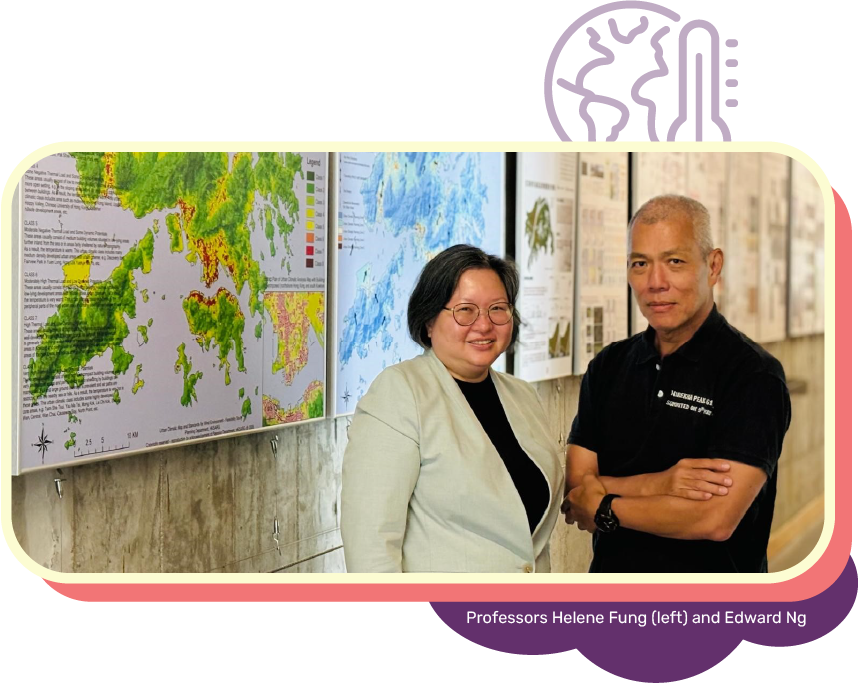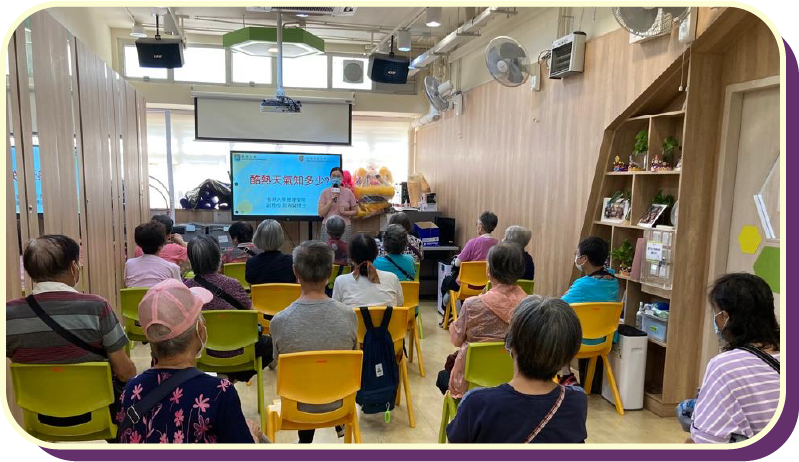Striving for climate justice for the underprivileged
Mitigating extreme weather
with urban design and elderly support

Wandering through the streets and alleys of Hong Kong has been a source of enjoyment for Professor Edward Ng Yan-yung since he came back in the 1990s after studying abroad. Back then, on a scorching summer day in Central, he spotted an old woman struggling to push a cart loaded with cardboard for recycling. The scene was imprinted on his mind, making him realize that there was a dearth of places in the city centre for seniors to rest and cool off. It prompted him to embark on a quarter-century journey for climate justice, applying his expertise in architecture to help build a more livable city.
‘You don’ t need to look far to find where research can make an impact. Just look around the city’, he says. ‘Once you see the problems, the next question is: what can we do?’
Professor Ng, currently Yao Ling Sun Endowed Chair in Architecture at The Chinese University of Hong Kong (CUHK), began his work on climate justice in the early 2000s. In the face of intensifying climate change and extreme weather, underprivileged groups, particularly the elderly, bear the brunt of these changes and are often forgotten by society. To address their needs, Professor Ng proactively seeks collaboration with experts from various fields such as nursing, psychology, engineering, and mathematics.
Supported by the Research Grants Council’s Research Impact Fund, Professor Ng has led a five-year interdisciplinary research project, titled ‘Extreme Hot Weather, High-Density Living and Senior Health in HK’, in collaboration with teams from CUHK, The University of Hong Kong, The Hong Kong University of Science and Technology and the City University of Hong Kong. The study, which began in 2019, focused on the effects of extreme heat on the city’s elderly and explored potential solutions.

by century’s end
Professor Ng’ s team employs a ‘global circulation model’ and a ‘weather research and forecasting model’, integrating complex data on Hong Kong’ s urban environment, including building densities, traffic flows, green spaces, and the planned developments of the Northern Metropolis and artificial islands in the central waters west of Hong Kong Island, alongside the foreseeable growth of the Greater Bay Area. With these, the team has developed a sophisticated mathematical model to simulate temperature changes across local districts under different carbon emission scenarios in the coming decades.
Professor Ng explains that it is a particularly arduous task to predict temperature changes across districts and over specific times, given the intricacies of urban microclimates. Using more than 500 computers, his team took three to four years to produce their results, and the findings are concerning.
Even under the conservative scenario of greenhouse gas emissions, the average temperature in Hong Kong is expected to rise by two to three degrees Celsius by the end of the century. The number of hot nights (daily minimum temperature over 28 ° C) will soar from around 30 days to over 120 days annually. Summer is projected to extend significantly from the current three months to five or six months, with a considerable increase in the number of consecutive hot days. Areas such as Sha Tin, Tuen Mun and Kowloon, which are insulated from sea breezes and affected by the urban heat island effect, are expected to be particularly hard hit.

The project team has shared its research findings on prolonged heat prediction and related health risks with the Hong Kong Observatory (HKO). The Observatory has enhanced its heat alert service in the past two years, including an upgrade of precautionary actions and warnings for the elderly associated with the very hot weather warning. It has also introduced a new alert on prolonged heat through the mobile app and official website, and a new ‘extremely hot’ weather warning when the actual or predicted temperatures either in the HKO Headquarters or in towns like Sha Tin and Tuen Mun in the New Territories reach 35°C.
The team did not stop there. Professor Ng further stresses his concern: ‘If we continue building homes as we do today, in 30 to 50 years, they will no longer be fit for habitation’. His team has simulated future urban climates, both indoors and outdoors, to identify architectural strategies to mitigate the impact of extreme heat.
Based on their findings, Professor Ng’s team has provided an easy-to-understand design guidebook for architectural practice to encourage improvement of the built environment in future development through adopting evidence-based heat mitigation strategies. The guidebook recommends careful designs of indoor and outdoor spaces, including higher ceiling heights, better window designs to allow for ventilation, improving airflow in kitchens, and the inclusion of shaded and cooling facilities in public areas. The team has obtained support from the Hong Kong Green Building Council to publish the guidebook, for architects, urban planners, landscape architects, engineers, interior designers and other professionals who appreciate the scale of the problem.
Professor Ng’s team have also approached the government’s housing officials, with proposals to increase the density and comfort of cooling facilities for the elderly in public housing, such as pavilions in parks. They also suggested eliminating metal materials for park benches that can become unbearably hot under the sun. He is pleased to see the government’s recent ‘well-being design’ guide addressing some of these recommendations.
‘We architects look at how we should build cities that adapt to new climates, but it’s equally important for us to help people live better in these environments’, says Professor Ng, underpinning the interdisciplinary collaboration in their research.
This brings in the other crucial aspect of the project: examining how extreme heat affects the elderly. Over the past three years, the research team has recruited around 300 old people in the community to have their summer living habits, perceptions and response strategies to heat tracked. They discovered that while the elderly people’s thermal perception, or the ability to sense heat, is similar to that of younger people, their thermal acceptance, or heat tolerance, is significantly higher, with considerable variations between individuals.
Professor Helene Fung Hoi-lam, Chairperson of CUHK’s Department of Psychology and a key member of the research team, explains that some elderly people show a high tolerance for heat: they endure discomfort without turning on air conditioning, wearing lighter clothing, or communicating their discomfort to family members. In some cases, this is due to financial concerns, while in others, it stems from their reluctance to burden their families.

In light of the findings, the team adopted multiple approaches to share information about heat-related health risks and extreme weather adaptation strategies with community elderly persons, their caregivers, such as foreign domestic helpers, healthcare practitioners, elderly community centres and also NGOs. For instance, six face-to-face or online health talks were conducted to disseminate heat-health knowledge to the elderly to raise their awareness and take necessary precautionary measures. Sharing sessions with Hong Kong Red Cross and Civil Aid Service were conducted. In addition, educational videos and educational leaflets were also produced and distributed to teach elderly people how to adapt to extreme hot weather. The team’s work caught the attention of a social worker network based in the Greater Bay Area, who approached CUHK in order to learn from their community education initiatives.
As the extreme heat study concluded, the research team has further secured funding from the Research Impact Fund to look at another climate problem: extreme cold. In their new project, ‘Extreme Cold Weather, High-Density Living and Senior Health in HK’, which started in 2023, the team are now investigating the effects of cold weather on the elderly. Professor Fung explains that the study explores the impacts of sudden temperature drops, which have become increasingly common in recent years, on the elderly population, and considers measures to mitigate them.
‘This project demonstrates how seemingly ‘out-of-touch’ climate and architectural research can be translated into tangible benefits for society, especially for the most vulnerable’, concludes Professor Fung.
Jessica Chu is an editor in the Communications and Public Relations Office, The Chinese University of Hong Kong.

